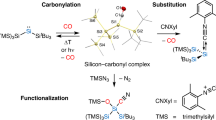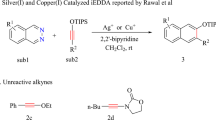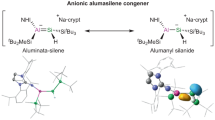Abstract
Silylium ions, or, to be more precise, donor-stabilized silylium-ion-like species, were once only the domain of computational and structural chemists. This was mainly due to the difficulties in generating and isolating these reactive species in a condensed phase. Even chemists focused on reactivity stayed away from such delicate ions. The state of affairs has changed in recent years as methods for their preparation have become more accessible and strategies for their stabilization more effective. Silylium ions have high electrophilicity, oxophilicity and fluorophilicity that have seen them emerge as useful catalysts, including for unique transformations not accessible to metal catalysts. This Perspective aims to provide a concise and conceptual summary of breakthroughs in this emerging area.
This is a preview of subscription content, access via your institution
Access options
Access Nature and 54 other Nature Portfolio journals
Get Nature+, our best-value online-access subscription
$29.99 / 30 days
cancel any time
Subscribe to this journal
Receive 12 digital issues and online access to articles
$119.00 per year
only $9.92 per issue
Buy this article
- Purchase on Springer Link
- Instant access to full article PDF
Prices may be subject to local taxes which are calculated during checkout





Similar content being viewed by others
References
Lee, V. Ya. & Sekiguchi, A. in Organosilicon Compounds (ed. Lee, V. Ya.) 197–230 (Academic, 2017).
Müller, T. in Functional Molecular Silicon Compounds I (ed. Scheschkewitz, D.) 107–162 (Springer, 2014).
Schulz, A. & Villinger, A. “Tamed” silylium ions: versatile in catalysis. Angew. Chem. Int. Ed. 51, 4526–4528 (2012).
Klare, H. F. T. & Oestreich, M. Silylium ions in catalysis. Dalton Trans. 39, 9176–9184 (2010).
Reed, C. A. The silylium ion problem, R3Si+. Bridging organic and inorganic chemistry. Acc. Chem. Res. 31, 325–332 (1998).
Lambert, J. B., Kania, L. & Zhang, S. Modern approaches to silylium cations in condensed phase. Chem. Rev. 95, 1191–1201 (1995).
Olah, G. A. 100 years of carbocations and their significance in chemistry. J. Org. Chem. 66, 5943–5957 (2001).
Kim, K.-C. et al. Crystallographic evidence for a free silylium ion. Science 297, 825–827 (2002).
Großekappenberg, H., Reißman, M., Schmidtmann, M. & Müller, T. Quantitative assessment of the Lewis acidity of silylium ions. Organometallics 34, 4952–4958 (2015).
Müther, K., Hrobárik, P., Hrobáriková, V., Kaupp, M. & Oestreich, M. The family of ferrocene-stabilized silylium ions: synthesis, 29Si NMR characterization, Lewis acidity, substituent scrambling, and quantum-chemical analyses. Chem. Eur. J. 19, 16579–16594 (2013).
Lambert, J. B. & Zhao, Y. The trimesitylsilylium cation. Angew. Chem. Int. Ed. Engl. 36, 400–401 (1997).
Lambert, J. B. & Lin, L. The tridurylsilylium and tridurylstannylium cations: free and not so free. J. Org. Chem. 66, 8537–8539 (2001).
Schäfer, A. et al. Synthesis of silylium and germylium ions by a substituent exchange reaction. Organometallics 32, 4713–4722 (2013).
Kira, M., Hino, T. & Sakurai, H. Chemistry of organosilicon compounds. 292. An NMR study of the formation of silyloxonium ions by using tetrakis[3,5-bis(trifluoromethyl)phenyl]borate as counteranion. J. Am. Chem. Soc. 114, 6697–6700 (1992).
Olah, G. A., Li, X.-Y., Wang, Q., Rasul, G. & Surya Prakash, G. K. Trisilyloxonium ions: preparation, NMR spectroscopy, ab initio/IGLO studies, and their role in cationic polymerization of cyclosiloxanes. J. Am. Chem. Soc. 117, 8962–8966 (1995).
Driess, M., Barmeyer, R., Monsé, C. & Merz, K. E(SiMe3)4 + ions (E=P, As): persilylated phosphonium and arsonium ions. Angew. Chem. Int. Ed. 40, 2308–2310 (2001).
Surya Prakash, G. K., Bae, C., Wang, Q., Rasul, G. & Olah, G. A. Tris(trimethylsilyl)sulfonium and methylbis(trimethylsilyl)sulfonium ions: preparation, NMR, spectroscopy, and theoretical studies. J. Org. Chem. 65, 7646–7649 (2000).
Reed, C. A., Xie, Z., Bau, R. & Benesi, A. Closely approaching the silylium ion (R3Si+). Science 262, 402–404 (1993).
Xie, Z. et al. A new weakly coordinating anion: approaching the silylium (silicenium) ion. J. Chem. Soc. Chem. Commun. 384–386 (1993).
Xie, Z. et al. Approaching the silylium (R3Si+) ion: trends with hexahalo (Cl, Br, I) carboranes as counterions. J. Am. Chem. Soc. 118, 2922–2928 (1996).
Fisher, S. P. et al. Nonclassical applications of closo-carborane anions: from main group chemistry and catalysis to energy storage. Chem. Rev. 119, 8262–8290 (2019).
Riddlestone, I. M., Kraft, A., Schaefer, J. & Krossing, I. Taming the cationic beast: novel developments in the synthesis and application of weakly coordinating anions. Angew. Chem. Int. Ed. 57, 13982–14024 (2018).
Hoffmann, S. P., Kato, T., Tham, F. S. & Reed, C. A. Novel weak coordination to silylium ions: formation of nearly linear Si–H–Si bonds. Chem. Commun. 767–769 (2006).
Connelly, S. J., Kaminsky, W. & Heinekey, D. M. Structure and solution reactivity of (triethylsilylium)triethylsilane cations. Organometallics 32, 7478–7481 (2013).
Romanato, P., Duttwyler, S., Linden, A., Baldridge, K. K. & Siegel, J. S. Intramolecular halogen stabilization of silylium ions directs gearing dynamics. J. Am. Chem. Soc. 132, 7828–7829 (2010).
Müller, T. A silyl cation with a three-centre Si–H–Si bond. Angew. Chem. Int. Ed. 40, 3033–3036 (2001).
Panisch, R., Bolte, M. & Müller, T. A. Hydrogen- and fluorine-bridged disilyl cations and their use in catalytic C–F activation. J. Am. Chem. Soc. 128, 9676–9682 (2006).
Lambert, J. B., Zhang, S., Stern, C. L. & Huffman, J. C. Crystal structure of a silyl cation with no coordination to anion and distant coordination to solvent. Science 260, 1917–1918 (1993).
Duttwyler, S., Do, Q.-Q., Linden, A., Baldridge, K. K. & Siegel, J. S. Synthesis of 2,6-diarylphenyldimethylsilyl cations: polar-π distribution of cation character. Angew. Chem. Int. Ed. 47, 1719–1722 (2008).
Wu, Q. et al. Catalytic difunctionalization of unactivated alkenes with unreactive hexamethyldisilane through regeneration of silylium ions. Angew. Chem. Int. Ed. https://doi.org/10.1002/anie.201911282 (2019).
Steinberger, H.-U., Müller, T., Auner, N., Maerker, C. & von Ragué Schleyer, P. The 2-silanorbornyl cation: an internally stabilized silyl cation. Angew. Chem. Int. Ed. Engl. 36, 626–628 (1997).
Klare, H. F. T., Bergander, K. & Oestreich, M. Taming the silylium ion for low-temperature Diels–Alder reactions. Angew. Chem. Int. Ed. 48, 9077–9079 (2009).
Müther, K., Fröhlich, R., Mück-Lichtenfeld, C., Grimme, S. & Oestreich, M. A unique transition metal-stabilized silicon cation. J. Am. Chem. Soc. 133, 12442–12444 (2011).
Bartlett, P. D., Condon, F. E. & Schneider, A. Exchanges of halogen and hydrogen between organic halides and isoparaffins in the presence of aluminum halides. J. Am. Chem. Soc. 66, 1531–1539 (1944).
Corey, J. Y. Generation of a silicenium ion in solution. J. Am. Chem. Soc. 97, 3237–3238 (1975).
Corey, J. Y., Gust, D. & Mislow, K. Generation of a ferrocenylsilicenium ion. J. Organomet. Chem. 101, C7–C8 (1975).
Bickart, P., Llort, F. M. & Mislow, K. On the evidence for the generation of a ferrocenylsilicenium ion. J. Organomet. Chem. 116, C1–C2 (1976).
Lambert, J. B. & Zhang, S. Tetrakis(pentafluorophenyl)borate: a new anion for silylium cations in the condensed phase. J. Chem. Soc. Chem. Commun. 383–384 (1993).
Chen, Q.-A., Klare, H. F. T. & Oestreich, M. Brønsted acid-promoted formation of stabilized silylium ions for catalytic Friedel–Crafts C–H silylation. J. Am. Chem. Soc. 138, 7868–7871 (2016).
Wu, Q. et al. Cleavage of unactivated Si–C(sp 3) bonds with Reed’s carborane acids: formation of known and unknown silylium ions. Angew. Chem. Int. Ed. 57, 9176–9179 (2018).
Lambert, J. B., Zhao, Y., Wu, H., Tse, W. C. & Kuhlmann, B. The allyl leaving group approach to tricoordinate silyl, germyl, and stannyl cations. J. Am. Chem. Soc. 121, 5001–5008 (1999).
Allemann, O., Duttwyler, S., Romanato, P., Baldridge, K. K. & Siegel, J. S. Proton-catalysed, silane-fuelled Friedel–Crafts coupling of fluoroarenes. Science 332, 574–577 (2011).
MacLachlan, M. J., Bourke, S. C., Lough, A. J. & Manners, I. Ring-opening protonolysis of strained silicon-containing rings: a new approach to ions with silylium character. J. Am. Chem. Soc. 122, 2126–2127 (2000).
Bourke, S. C., MacLachlan, M. J., Lough, A. J. & Manners, I. Ring-opening protonolysis of sila[1]ferrocenophanes as a route to stabilized silylium ions. Chem. Eur. J. 11, 1989–2000 (2005).
Simonneau, A., Biberger, T. & Oestreich, M. The cyclohexadienyl-leaving-group approach toward donor-stabilized silylium ions. Organometallics 34, 3927–3929 (2015).
Schäfer, A. et al. A new synthesis of triarylsilylium ions and their application in dihydrogen activation. Angew. Chem. Int. Ed. 50, 12636–12638 (2011).
Omann, L. et al. Thermodynamic versus kinetic control in substituent redistribution reactions of silylium ions steered by the counterion. Chem. Sci. 9, 5600–5607 (2018).
Wu, Q. et al. Characterization of hydrogen-substituted silylium ions in the condensed phase. Science 365, 168–172 (2019).
Jutzi, P. & Bunte, E.-A. [(π-Me5C5)2SiH]+ — a novel silyl cation. Angew. Chem. Int. Ed. Engl. 31, 1605–1607 (1992).
Oishi, M. in Lewis Acids in Organic Synthesis (ed. Yamamoto, H.) 355–393 (Wiley-VCH, 2000).
Dilman, A. D. & Ioffe, S. L. Carbon–carbon bond forming reactions mediated by silicon Lewis acids. Chem. Rev. 103, 733–772 (2003).
Shaykhutdinova, P., Keess, S. & Oestreich, M. in Organosilicon Chemistry: Novel Approaches and Reactions (eds Hiyama, T. & Oestreich, M.) 131–170 (Wiley-VCH, 2019).
Mathieu, B. & Ghosez, L. N-trimethylsilyl-bis(trifluoromethanesulfonyl)imide: a better carbonyl activator than trimethylsilyl triflate. Tetrahedron Lett. 38, 5497–5500 (1997).
Mathieu, B. & Ghosez, L. Trimethylsilyl bis(trifluoromethanesulfonyl)imide as a tolerant and environmentally benign Lewis acid catalyst of the Diels–Alder reaction. Tetrahedron 58, 8219–8226 (2002).
Hara, K., Akiyama, R. & Sawamura, M. Strong counterion effects on the catalytic activity of cationic silicon Lewis acids in Mukaiyama aldol and Diels–Alder reactions. Org. Lett. 7, 5621–5623 (2005).
Schmidt, R. K., Klare, H. F. T., Fröhlich, R. & Oestreich, M. Planar chiral, ferrocene-stabilized silicon cations. Chem. Eur. J. 22, 5376–5383 (2016).
Johannsen, M., Jørgensen, K. A. & Helmchen, G. Synthesis and application of the first chiral and highly Lewis acidic silyl cationic catalyst. J. Am. Chem. Soc. 120, 7637–7638 (1998).
Rohde, V. H. G., Müller, M. F. & Oestreich, M. Intramolecularly sulfur-stabilized silicon cations with chiral binapthyl backbones: synthesis of three different motifs and their application in enantioselective Diels–Alder reactions. Organometallics 34, 3358–3373 (2015).
Shaykhutdinova, P. & Oestreich, M. Achieving enantioselectivity in difficult cyclohexa-1,3-diene Diels–Alder reactions with sulfur-stabilized silicon cations as Lewis acid catalysts. Org. Lett. 20, 7029–7033 (2018).
Schreyer, L., Properzi, R. & List, B. IDPi catalysis. Angew. Chem. Int. Ed. 58, 12761–12777 (2019).
Gatzenmeier, T. et al. Asymmetric Lewis acid organocatalysis of the Diels–Alder reaction by a silylated C–H acid. Science 351, 949–952 (2016).
Gatzenmeier, T. et al. Scalable and highly diastereo- and enantioselective catalytic Diels–Alder reaction of α,β-unsaturated methyl esters. J. Am. Chem. Soc. 140, 12671–12676 (2018).
Stahl, T., Klare, H. F. T. & Oestreich, M. Main-group Lewis acids for C–F bond activation. ACS Catal. 3, 1578–1587 (2013).
Meier, G. & Braun, T. Catalytic C–F activation and hydrodefluorination of fluoroalkyl groups. Angew. Chem. Int. Ed. 48, 1546–1548 (2009).
Mitsuo, K., Takakazu, H. & Hideki, S. Siloxycarbenium tetrakis[3,5-bis(trifluoromethyl)phenyl]borates and their role in reactions of ketones with nucleophiles. Chem. Lett. 21, 555–558 (1992).
Müther, K. & Oestreich, M. Self-regeneration of a silylium ion catalyst in carbonyl reduction. Chem. Commun. 47, 334–336 (2011).
Müther, K., Mohr, J. & Oestreich, M. Silylium ion promoted reduction of imines with hydrosilanes. Organometallics 32, 6643–6646 (2013).
Gatzenmeier, T., Kaib, P. S. J., Lingnau, J. B., Goddard, R. & List, B. The catalytic asymmetric Mukaiyama–Michael reaction of silyl ketene acetals with α,β-unsaturated methyl esters. Angew. Chem. Int. Ed. 57, 2464–2468 (2018).
Mahlau, M., Garcia-Garcia, P. & List, B. Asymmetric counteranion-directed catalytic Hosomi–Sakurai reaction. Chem. Eur. J. 18, 16283–16287 (2012).
Klare, H. F. T. Catalytic C–H arylation of unactivated C–H bonds by silylium ion-promoted C(sp 2)–F bond activation. ACS Catal. 7, 6999–7002 (2017).
Duttwyler, S. et al. C–F activation of fluorobenzene by silylium carboranes: evidence for incipient phenyl cation reactivity. Angew. Chem. Int. Ed. 49, 7519–7522 (2010).
Allemann, O., Baldridge, K. K. & Siegel, J. S. Intramolecular C–H insertion vs. Friedel–Crafts coupling induced by silyl cation-promoted C–F activation. Org. Chem. Front. 2, 1018–1021 (2015).
Wang, Y. et al. Chiral atropisomeric indenocorannulene bowls: critique of the Cahn–Ingold–Prelog conception of molecular chirality. Angew. Chem. Int. Ed. 57, 6470–6474 (2018).
Dosso, J. et al. Synthesis and optoelectronic properties of hexa-peri-hexabenzoborazinocoronene. Angew. Chem. Int. Ed. 56, 4483–4487 (2017).
Shao, B., Bagdasarian, A. L., Popov, S. & Nelson, H. M. Arylation of hydrocarbons enabled by organosilicon reagents and weakly coordinating anions. Science 355, 1403–1407 (2017).
Popov, S. et al. Teaching an old carbocation new tricks: intermolecular C–H insertion reactions of vinyl cations. Science 361, 381–387 (2018).
Bähr, S. & Oestreich, M. Electrophilic aromatic substitution with silicon electrophiles: catalytic Friedel–Crafts C–H silylation. Angew. Chem. Int. Ed. 56, 52–59 (2017).
Cacace, F., Crestoni, M. E., de Petris, G., Fornarini, S. & Grandinetti, F. A comparative study of gas phase aromatic desilylation and detertbutylation by charged electrophiles. Can. J. Chem. 66, 3099–3107 (1988).
Furukawa, S., Kobayashi, J. & Kawashima, T. Development of a sila-Friedel–Crafts reaction and its application to the synthesis of dibenzosilole derivatives. J. Am. Chem. Soc. 131, 14192–14193 (2009).
Furukawa, S., Kobayashi, J. & Kawashima, T. Application of the sila-Friedel–Crafts reaction to the synthesis of π-extended silole derivatives and their properties. Dalton Trans. 39, 9329–9336 (2010).
Curless, L. D., Clark, E. R., Dunsford, J. J. & Ingleson, M. J. E–H (E=R3Si or H) bond activation by B(C6F5)3 and heteroarenes; competitive dehydrosilylation, hydrosilylation and hydrogenation. Chem. Commun. 50, 5270–8272 (2014).
Curless, L. D. & Ingleson, M. J. B(C6F5)3-catalyzed synthesis of benzofused-siloles. Organometallics 33, 7241–7246 (2014).
Yin, Q., Klare, H. F. T. & Oestreich, M. Friedel–Crafts-type intermolecular C–H silylation of electron-rich arenes initiated by base-metal salts. Angew. Chem. Int. Ed. 55, 3204–3207 (2016).
Ma, Y., Wang, B., Zhang, L. & Hou, Z. Boron-catalyzed aromatic C–H bond silylation with hydrosilanes. J. Am. Chem. Soc. 138, 3663–3666 (2016).
Klare, H. F. T. et al. Cooperative catalytic activation of Si–H bonds by a polar Ru–S bond: regioselective low-temperature C–H silylation of indoles under neutral conditions by a Friedel–Crafts mechanism. J. Am. Chem. Soc. 133, 3312–3315 (2011).
Omann, L. & Oestreich, M. A catalytic SEAr approach to dibenzosiloles functionalized at both benzene cores. Angew. Chem. Int. Ed. 54, 10276–10279 (2015).
Acknowledgements
J.C.L.W. gratefully acknowledges the Alexander von Humboldt Foundation for a Theodor Heuss Fellowship (2018–2019). M.O. is indebted to the Einstein Foundation Berlin for an endowed professorship.
Author information
Authors and Affiliations
Contributions
All authors contributed equally to the preparation of this manuscript.
Corresponding author
Ethics declarations
Competing interests
The authors declare no competing interests.
Additional information
Publisher’s note
Springer Nature remains neutral with regard to jurisdictional claims in published maps and institutional affiliations.
Rights and permissions
About this article
Cite this article
Walker, J.C.L., Klare, H.F.T. & Oestreich, M. Cationic silicon Lewis acids in catalysis. Nat Rev Chem 4, 54–62 (2020). https://doi.org/10.1038/s41570-019-0146-7
Accepted:
Published:
Issue Date:
DOI: https://doi.org/10.1038/s41570-019-0146-7
This article is cited by
-
Silylium ions: from controversial beginnings to useful catalysts
Nature Reviews Chemistry (2019)



